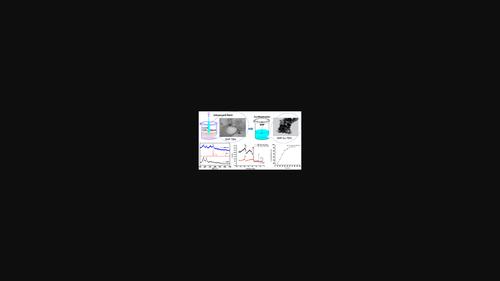当前位置:
X-MOL 学术
›
Can. J. Chem. Eng.
›
论文详情
Our official English website, www.x-mol.net, welcomes your
feedback! (Note: you will need to create a separate account there.)
Cu(II) ions removal from wastewater using starch nanoparticles (SNPs): An eco-sustainable approach
The Canadian Journal of Chemical Engineering ( IF 1.6 ) Pub Date : 2022-08-04 , DOI: 10.1002/cjce.24588 Vikas S. Hakke 1 , Vividha K. Landge 1 , Shirish H. Sonawane 1 , G. Uday Bhaskar Babu 1 , Sivakumar Manickam 2 , Grzegorz Boczkaj 3, 4
The Canadian Journal of Chemical Engineering ( IF 1.6 ) Pub Date : 2022-08-04 , DOI: 10.1002/cjce.24588 Vikas S. Hakke 1 , Vividha K. Landge 1 , Shirish H. Sonawane 1 , G. Uday Bhaskar Babu 1 , Sivakumar Manickam 2 , Grzegorz Boczkaj 3, 4
Affiliation

|
The complex structured starch particles were reduced to the nanoscale size range through hydrolysis utilizing low concentration acid assisted by ultrasound irradiation. The synthesized starch nanoparticles (SNPs) were characterized by transmission electron microscopy (TEM), Fourier-transform infrared (FTIR), and X-ray diffraction (XRD) techniques. The synthesized SNPs possessed surface activated entities, as many cationic functional groups were confirmed through the FTIR spectrum. Also, these SNPs were effectively utilized to separate heavy Cu metal ions from the synthetic ion solution. The SNPs were characterized using field emission scanning electron microscope (FESEM), X-ray photoelectron spectroscopy (XPS), and Brunauer–Emmett–Teller (BET) analysis for the surface modification after the adsorption process. The weak electrostatic interaction between the SNP surface and Cu ion was confirmed by the XPS spectrum and energy-dispersive X-ray spectroscopy. The maximum efficiency of Cu ions removal was about 93% at an optimal pH 5 and 25 mg/ml dosage. The adsorption equilibrium was obtained in 60 min. The nitrogen isotherm BET analysis of SNPs after adsorption shows a higher specific surface area of 18.552 m2/g, attributed to the interaction and presence of Cu ions on the SNP surface. The process feasibility was validated by the Langmuir isotherm model. The process exhibits pseudo-second-order adsorption kinetics and follows the Langmuir isotherm. The RL predicted by the Langmuir isotherm mechanism is 0.017, implying favourable adsorption. The process is reproducible and allows for the separation of heavy metal ions from the wastewater through biosorption effectively.
中文翻译:

使用淀粉纳米颗粒 (SNP) 从废水中去除 Cu(II) 离子:一种生态可持续的方法
复杂的结构化淀粉颗粒通过超声辐射辅助下的低浓度酸水解减少到纳米级尺寸范围。通过透射电子显微镜 (TEM)、傅立叶变换红外 (FTIR) 和 X 射线衍射 (XRD) 技术对合成的淀粉纳米颗粒 (SNP) 进行了表征。合成的 SNP 具有表面活化实体,因为通过 FTIR 光谱证实了许多阳离子官能团。此外,这些 SNP 还被有效地用于从合成离子溶液中分离重铜金属离子。使用场发射扫描电子显微镜 (FESEM)、X 射线光电子能谱 (XPS) 和 Brunauer-Emmett-Teller (BET) 分析对吸附过程后的表面改性进行 SNP 表征。XPS 光谱和能量色散 X 射线光谱证实了 SNP 表面与 Cu 离子之间的弱静电相互作用。在最佳 pH 值 5 和 25 mg/ml 剂量下,Cu 离子去除的最大效率约为 93%。60 分钟后达到吸附平衡。吸附后 SNPs 的氮等温线 BET 分析显示更高的比表面积为 18.552 m2 /g,归因于 SNP 表面上 Cu 离子的相互作用和存在。通过 Langmuir 等温线模型验证了工艺可行性。该过程表现出伪二级吸附动力学并遵循朗缪尔等温线。Langmuir 等温线机制预测的 R L 为 0.017,表明吸附有利。该过程是可重复的,并允许通过生物吸附有效地从废水中分离重金属离子。
更新日期:2022-08-04
中文翻译:

使用淀粉纳米颗粒 (SNP) 从废水中去除 Cu(II) 离子:一种生态可持续的方法
复杂的结构化淀粉颗粒通过超声辐射辅助下的低浓度酸水解减少到纳米级尺寸范围。通过透射电子显微镜 (TEM)、傅立叶变换红外 (FTIR) 和 X 射线衍射 (XRD) 技术对合成的淀粉纳米颗粒 (SNP) 进行了表征。合成的 SNP 具有表面活化实体,因为通过 FTIR 光谱证实了许多阳离子官能团。此外,这些 SNP 还被有效地用于从合成离子溶液中分离重铜金属离子。使用场发射扫描电子显微镜 (FESEM)、X 射线光电子能谱 (XPS) 和 Brunauer-Emmett-Teller (BET) 分析对吸附过程后的表面改性进行 SNP 表征。XPS 光谱和能量色散 X 射线光谱证实了 SNP 表面与 Cu 离子之间的弱静电相互作用。在最佳 pH 值 5 和 25 mg/ml 剂量下,Cu 离子去除的最大效率约为 93%。60 分钟后达到吸附平衡。吸附后 SNPs 的氮等温线 BET 分析显示更高的比表面积为 18.552 m2 /g,归因于 SNP 表面上 Cu 离子的相互作用和存在。通过 Langmuir 等温线模型验证了工艺可行性。该过程表现出伪二级吸附动力学并遵循朗缪尔等温线。Langmuir 等温线机制预测的 R L 为 0.017,表明吸附有利。该过程是可重复的,并允许通过生物吸附有效地从废水中分离重金属离子。











































 京公网安备 11010802027423号
京公网安备 11010802027423号